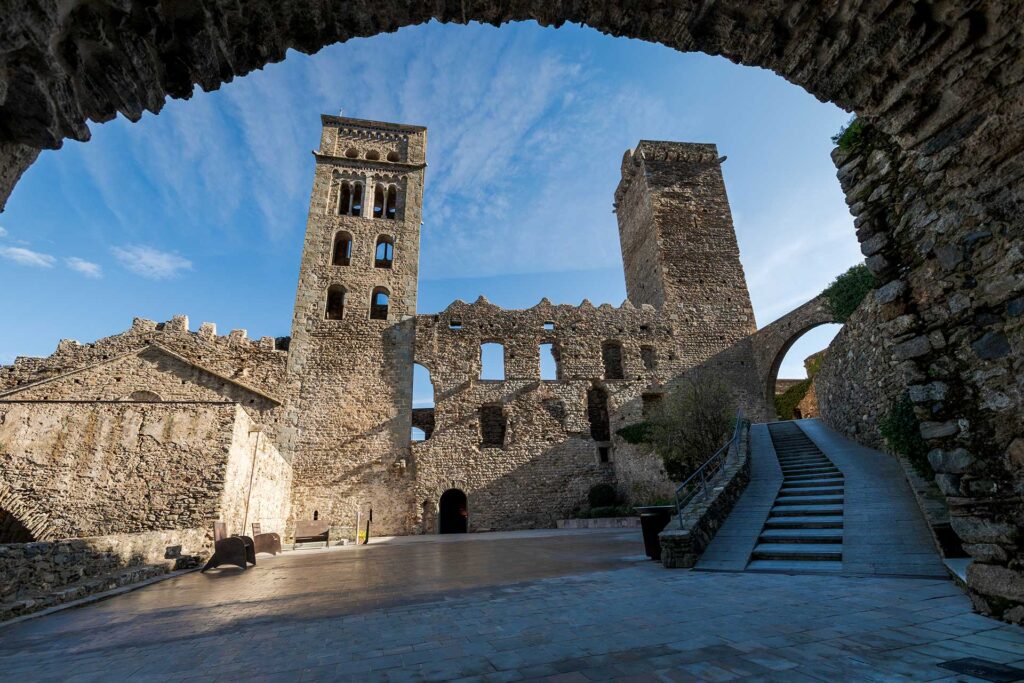
The Sant Pere de Rodes Monastery is one of many testimonies to Catalan Romanesque architecture, but it is perhaps one of the most architecturally sophisticated. From the 11th to the 14th century, it was the main spiritual centre of the County of Empúries and its splendour is shown in the large dimensions of the monastic complex. The complex consists of the church, the bell tower, the cloister, the sacristies, the traditional residential buildings as well as the Abbot’s palace. The monastery is built on terraces in order to adapt to the terrain and the various buildings, erected between the 10th and 11th centuries, are distributed around the cloister and the church. Outside, the large portal, designed by the Master of Cabestany, displayed various scenes of the life of Christ carved in white marble. The few fragments that have survived down to today show its extraordinary quality, probably one of the best of its time.
This is an iconic image of the monastery of Sant Pere de Rodes, which belongs to the photographic collection of Joaquim Fort Ribot, from 1960 and which is in the Empordà Museum. It is a photograph that allows us to see its condition before the restoration process carried out in the building in recent years. The abbot's palace was still completely ruined, as was the cellar in the foreground. Another interesting element to highlight is the accesses, as what can be seen today has been substantially modified.
Literary Text
The twenty-first charm of the Empordà are the ruins of Sant Pere de Roda. The monks have fled; the holy relics were scattered over distant monasteries, the altars do not serve the holy images, nor the candlesticks, nor the ancient antipendia. In the Benedictine cells there is no trace of the old incipits that Friar Gerbert read so many centuries ago; the Bible, gilded with love of naive Romanesque figures, is confined in a foreign Museum. But neither the hand of men nor the insults of time have been able to strip the plundered and collapsed ruins of their cordial charm. Like an old sandalwood ark, each time it is split, with the last splinters it renews its perfume. From the Greek Rhodes you took your Christian name in the initial days of the Benedictine colonisation. Like a dead star, having been the guiding light for the feelings and reason for mankind for many centuries, you now remain dull in your majestic solitude. But at night you are not lost or forgotten, a dead star of a homeland that does not want to die. Up the coast through the vineyards of Palau-saverdera, what sweet red grapes are grown there! I climbed, like a passionate pilgrim, along the same routes that my father had followed, and I felt the poignant emotion of adored memories, as I stepped on the ruins of the old Catalan monastery. And then, when I went up to the castle of Sant Salvador, the land of the Empordà seemed even flatter and more resplendent, and I delightedly followed the coves of the coast and contemplated the immense sea, so polished and clear that it showed the reflection of the sun.
From LES GRÀCIES DE L'EMPORDÀ (THE CHARMS OF EMPORDÀ), by Pere Coromines
Text published on the Espais Escrits mapaliterari.cat website. Catalan Literary Heritage Network.
Location
-
Lloc Monestir Sant Pere De Roda 6, 17489 Puerto de la Selva, Provincia de Gerona, España


Add a review